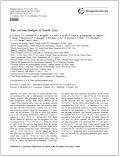| Journal Article |
 |
|
| Article Title | The carbon budget of South Asia | | Author | P. K. Patra, J. G. Canadell, R. A. Houghton, S. L. Piao, N.-H. Oh, P. Ciais, K. R. Manjunath, A. Chhabra, T. Wang, T. Bhattacharya, P. Bousquet, J. Hartman, A. Ito, E. Mayorga, Y. Niwa, P. A. Raymond, V. V. S. S. Sarma and Rodel D. Lasco | | Year | 2013 | | Journal Title | Biogeosciences | | Institution | the European Geosciences Union | | Volume | 10 | | Pages | 513–527 | | Call Number | JA0478-13 |
|
| Abstract: |
| The source and sinks of carbon dioxide (CO2)
and methane (CH4) due to anthropogenic and natural biospheric
activities were estimated for the South Asian region
(Bangladesh, Bhutan, India, Nepal, Pakistan and Sri
Lanka). Flux estimates were based on top-down methods
that use inversions of atmospheric data, and bottom-up methods
that use field observations, satellite data, and terrestrial
ecosystem models. Based on atmospheric CO2 inversions,
the net biospheric CO2 flux in South Asia (equivalent
to the Net Biome Productivity, NBP) was a sink, estimated
at ?104±150 TgCyr?1 during 2007–2008. Based
on the bottom-up approach, the net biospheric CO2 flux
is estimated to be ?191±193 TgCyr?1 during the period
of 2000–2009. This last net flux results from the following
flux components: (1) the Net Ecosystem Productivity,
NEP (net primary production minus heterotrophic respiration)
of ?220±186 TgCyr?1 (2) the annual net carbon
flux from land-use change of ?14±50 TgCyr?1, which resulted
from a sink of ?16 TgCyr?1 due to the establishment
of tree plantations and wood harvest, and a source of
2 TgCyr?1 due to the expansion of croplands; (3) the riverine
export flux from terrestrial ecosystems to the coastal
oceans of +42.9 TgCyr?1; and (4) the net CO2 emission
due to biomass burning of +44.1±13.7 TgCyr?1. Including
the emissions from the combustion of fossil fuels of
444 TgCyr?1 for the 2000s, we estimate a net CO2 land–
atmosphere flux of 297 TgCyr?1. In addition to CO2, a fraction
of the sequestered carbon in terrestrial ecosystems is
released to the atmosphere as CH4. Based on bottom-up
and top-down estimates, and chemistry-transport modeling,
we estimate that 37±3.7 TgC-CH4 yr?1 were released to
atmosphere from South Asia during the 2000s. Taking all
CO2 and CH4 fluxes together, our best estimate of the
net land–atmosphere CO2-equivalent flux is a net source
of 334 TgCyr?1 for the South Asian region during the
2000s. If CH4 emissions are weighted by radiative forcing
of molecular CH4, the total CO2-equivalent flux increases to
1148 TgCyr?1 suggesting there is great potential of reducing
CH4 emissions for stabilizing greenhouse gases concentrations. |
|
|
Download file(s): Click icon to download/open file.
|
| |
File Size |
Description |

|
- |
URL |
|
|
GRP 5: Improving the ability of farmers, ecosystems & governments to cope with climate change
|
| Viewed in 1983 times. Downloaded in 361 times. |